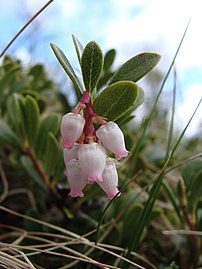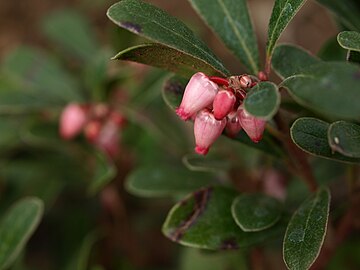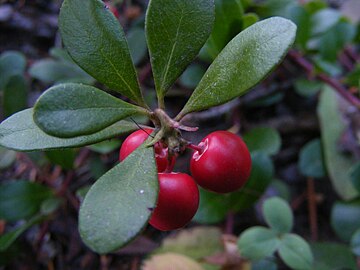Arctostaphylos uva-ursi
| Arctostaphylos uva-ursi | |
|---|---|

| |
| Scientific classification | |
| Kingdom: | Plantae |
| Clade: | Tracheophytes |
| Clade: | Angiosperms |
| Clade: | Eudicots |
| Clade: | Asterids |
| Order: | Ericales |
| Family: | Ericaceae |
| Genus: | Arctostaphylos |
| Species: | A. uva-ursi
|
| Binomial name | |
| Arctostaphylos uva-ursi (
Spreng. | |
| Synonyms[2] | |
|
List
| |
Arctostaphylos uva-ursi is a plant species of the genus .
One of several related species referred to as
Description
Arctostaphylos uva-ursi is a small procumbent woody groundcover shrub growing to 5–30 centimetres (2–12 inches) high.[7] Wild stands of the species can be dense, with heights rarely taller than 15 cm (6 in). Erect branching twigs emerge from long flexible prostrate stems, which are produced by single roots. The trailing stems will layer, sending out small roots periodically. The finely textured velvety branches are initially white to pale green, becoming smooth and red-brown with maturity.[3] The small solitary three-scaled buds are dark brown.
The
Terminal clusters of small urn-shaped flowers bloom from May to June. The flowers are white to pink,
-
Illustration from Köhler's Medicinal Plants (1887)
-
Flowers
-
Flowers
-
A. uva-ursi subsp. uva-ursi fruit
Chemistry
The plant contains diverse phytochemicals, including ursolic acid, tannic acid, gallic acid, some essential oils and resin, hydroquinones (mainly arbutin, up to 17%), tannins (up to 15%), phenolic glycosides and flavonoids.[10]
Subspecies
As many as 14 subspecies have been accepted,[11] however as of 2024 they are considered synonyms by major sources such as Plants of the World Online and World Flora Online.[2][12]
Etymology
The
The common name, kinnikinnick, is an
Distribution and habitat
The distribution of Arctostaphylos uva-ursi is circumpolar, and it is widespread in northern latitudes,[3][11][5] but confined to high altitudes further south:
- in Europe, from mountains);
- in Asia from arctic Himalaya;
- in North America from arctic Alaska, Canada and Central Coast, California, San Francisco Bay Area, to New Mexico in the Rocky Mountains; and the Appalachian Mountains in the northeast United States. It is prevalent across all regions of British Columbia and Alberta.[3][4]
Ecology
It is a
Arctostaphylos uva-ursi is an
Bears and other animals eat the berries.[15]
Conservation
The plant is rare or
Toxicity
One review indicated that ingestion of large doses can cause
The leaves contain arbutin,
Uses
Bearberry fruits and leaves are used by members of the
Dried bearberry leaves are the main component in many traditional North American Native smoking mixes,[4][24] known collectively as "kinnikinnick" (Algonquin for "smoking mixture") used especially among western First Nations, often including other herbs and sometimes tobacco.[4][7][16]
Native Americans also used the plant to make yellow dye.[14]
There are several cultivars that are propagated for use as ornamental plants.[4] It is an attractive year-round evergreen groundcover for gardens, and is useful for controlling erosion on hillsides and slopes due to its deep roots.[7] It is tolerant of sun and dry soils, and is thus common groundcover in urban areas, in naturalized areas, and in native plant or rock gardens.[3][7] As the seeds are difficult to germinate they are most often propagated using rooted stems.[25]
References
- ^ NatureServe (2023). "Arctostaphylos uva-ursi Bearberry". NatureServe Explorer. Arlington, Virginia: NatureServe. Retrieved 17 April 2023.
- ^ a b "Arctostaphylos uva-ursi (L.) Spreng". Plants of the World Online. Royal Botanic Gardens, Kew. Retrieved 26 March 2024.
- ^ a b c d e f g h i j k "Arctostaphylos uva-ursi (L.) Spreng; E-Flora: Electronic atlas of the flora of British Columbia; In: Klinkenberg, Brian. (Editor)". E-Flora BC, Department of Geography, University of British Columbia Herbarium. 2018. Archived from the original on 2018-04-04. Retrieved 2019-08-27.
- ^ a b c d e f g h "Common bearberry". Alberta Plant Watch, Government of Alberta. 2019. Retrieved 2019-08-27.
- ^ a b c d "Plant fact sheet: Bearberry (Arctostaphylos uva-ursi)" (PDF). USDA NRCS Northeast Plant Materials Program. 31 January 2002.
- ISBN 0-9665463-1-8.
- ^ a b c d e f g h i j k l "Arctostaphylos uva-ursi; 'Massachusetts'". Missouri Botanical Garden. 2019. Retrieved 27 August 2019.
- ^ )
- ^ ISBN 0521232902.
- S2CID 37247418.
- ^ a b "Plants profile for Arctostaphylos uva-ursi (kinnikinnick)". USDA Plants. 2019. Retrieved 2019-08-27.
- ^ "Arctostaphylos uva-ursi (L.) Spreng". World Flora Online. Retrieved 26 March 2024.
- ISBN 978-0-933994-22-5.
The name Arctostaphylos is from Greek: arctos = bear, staphylos = bunch of grapes or berries; hence bearberry, pertaining redundantly to A. uva-ursi (Latin: uva = berry, ursi = of the bear).
- ^ a b c Patterson, Patricia A. (1985). Field Guide to the Forest Plants of Northern Idaho (PDF). United States Department of Agriculture Forest Service. pp. 37–47.
- ^ Reiner, Ralph E. (1969). Introducing the Flowering Beauty of Glacier National Park and the Majestic High Rockies. Glacier Park, Inc. p. 114.
- ^ a b c d e f g "Uva ursi". Drugs.com. 19 July 2017. Retrieved 27 August 2019.
- ^ a b c "Arbutin, CID 440936". PubChem, National Library of Medicine, US National Institutes of Health. 16 November 2019. Retrieved 19 November 2019.
- S2CID 24225098.
- ^ Hellson, John C. (1974). Ethnobotany of the Blackfoot Indians. Ottawa: National Museums of Canada. p. 101.
- OCLC 668195076.
- ISBN 0415927463.
- ISBN 0-394-50432-1.
- ISBN 0-394-73127-1.
- ISBN 0-88192-453-9.
- ISBN 0-8166-1127-0.





